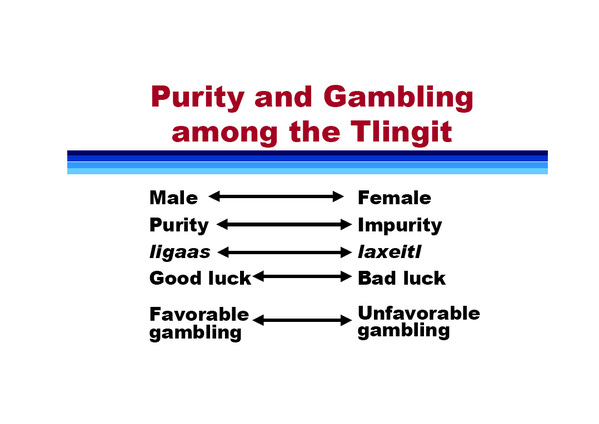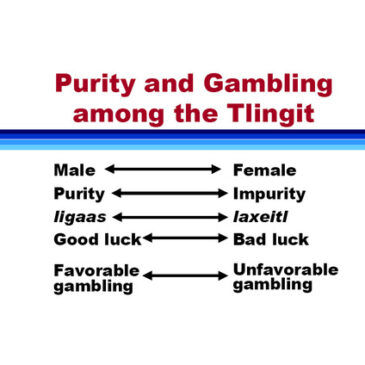There is a school of social anthropologists who hold that studying other cultures increases our ability to think critically about our own. It is not uncommon for a returning expatriate to remark, "I never realized how [adjective] we Americans are until I spent time in [foreign locale]!" Looking at the childrearing customs of the Yanomamo of Brazil can provide a new perspective on our own practices, just as Margaret Mead’s seminal study, Coming of age in Samoa can shed light on our own rites of adolescence and courtship. Similarly, Michael Heine’s treatment of gambling among the Tlingit culture provides us with a cross-cultural backdrop against which we can study our own gambling mores.
The Tlingit are a coastal people who live by fishing and gathering in southeastern Alaska. Ethnographic literature is replete with references to the role of gambling and competitive games in Tlingit culture, as well as the relative absence of women from these activities. Heine sets out to explore the latter issue. There is, he notes, nothing explicit in Tlingit cosmology that prohibits female participation. On the contrary, there exist several admonishments concerning excessive gambling, but these warnings are primarily aimed at men. So whence the gendered nature of Tlingit gambling? Heine cites several explanations:
1. Although a plentiful food supply permits leisure by freeing the Tlingit from subsistence production, this leisure time is not enjoyed equally between the genders. Women must work longer than men to fulfill their assigned work and roles. This workload limits the amount of time they may devote to gambling activities.
2. Women generally do not own the type of personal property commonly wagered by Tlingit men. Without access to the capital required to participate in gambling events, women are excluded.
3. Notions of purity and impurity are inherently linked to gender among the Tlingit. Physiological purity is equated with moral purity, a concept denoted by the Tlingit word ligaas. The opposite concept is laxeitl, or impurity. As in many cultures, menstrual blood is generallly considered impure, thus placing menstruating females in a state of laxeitl. In this way, women are physiologically linked to laxeitl in a way that men are not. Furthermore, the Tlingit closely associate impurity with bad luck, a condition most unwelcome in gambling circles. Heine’s set of structural
oppositions are summarized in the figure below:
Thus, although there are no direct, explicit rules keeping Tlingit women from gambling, cultural norms and circumstances prevent it. In our own culture, too, gambling is a gendered activity. That is, the way in which we gamble varies according to our gender role. But what are the attributes of our culture that are responsible for this gendering? This is an important research question for both anthropologists and students of gambling studies. And since culture is not static, it is important to consider changes over time. The mores and cultural factors that influence the way we gamble today may be very different than those of the last century, or even last year.
Source: Heine, M.K. (1991). The symbolic capital of honor: Gambling games and the social construction of gender in Tlingit Indian culture. Play & Culture, 4, 346-358.
The WAGER is a public education project of the Division on Addictions at Harvard Medical School. It is funded, in part, by the Massachusetts Council on Compulsive Gambling, the Andrews Foundation, and the National Center for
Responsible Gaming.




